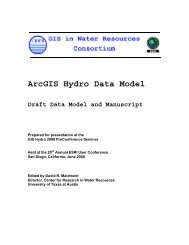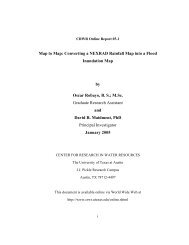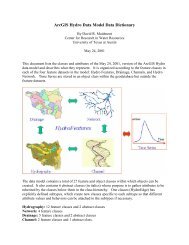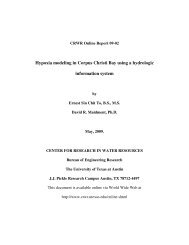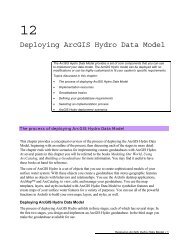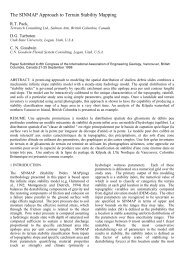View the Whole Report - Center for Research in Water Resources ...
View the Whole Report - Center for Research in Water Resources ...
View the Whole Report - Center for Research in Water Resources ...
You also want an ePaper? Increase the reach of your titles
YUMPU automatically turns print PDFs into web optimized ePapers that Google loves.
size and is <strong>the</strong> estimated largest pore size <strong>in</strong> <strong>the</strong> fabric. These tests may not give an<br />
accurate <strong>in</strong>dication of per<strong>for</strong>mance <strong>in</strong> <strong>the</strong> field. Mart<strong>in</strong> (1985) states:<br />
It can easily be shown <strong>in</strong> <strong>the</strong> lab and <strong>in</strong> <strong>the</strong> field that a fabric with a high<br />
clean water fabric flow rate does not necessarily per<strong>for</strong>m well <strong>in</strong> a<br />
sediment control application. Many dra<strong>in</strong>age fabrics have very high clean<br />
water flow rates. However, <strong>the</strong>ir slurry flow rates are very low because<br />
<strong>the</strong>ir fabric structure traps sediment and <strong>in</strong>hibits slurry flow.<br />
2.4.1 Geotextile Fabric<br />
Burlap was <strong>the</strong> filter fabric of choice prior to <strong>the</strong> <strong>in</strong>troduction of geotextiles.<br />
Un<strong>for</strong>tunately, burlap was highly susceptible to environmental decay and <strong>the</strong> filtration<br />
efficiency was questionable (Dallaire, 1976). Geotextiles typically are specified as <strong>the</strong><br />
filter fabric <strong>for</strong> silt fence applications (Mart<strong>in</strong>, 1985; TxDOT, 1992a).<br />
The def<strong>in</strong>ition of a geotextile is:<br />
any permeable textile used with foundation, soil, rock, or any o<strong>the</strong>r<br />
geotechnical eng<strong>in</strong>eer<strong>in</strong>g related material as an <strong>in</strong>tegral part of a manmade<br />
product, structure, or system (American Society of Test<strong>in</strong>g and<br />
Materials (ASTM), 1987b).<br />
The manufacture of geotextiles orig<strong>in</strong>ated as an offshoot of <strong>the</strong> chemical and cloth<strong>in</strong>g<br />
<strong>in</strong>dustries and provides a use <strong>for</strong> waste products and excess production capacities<br />
(Kulzer, 1988). Geotextiles are manufactured from syn<strong>the</strong>tic fibers or filaments such as<br />
polyester, polypropylene, or polyethylene which are bonded toge<strong>the</strong>r by a mechanical,<br />
<strong>the</strong>rmal, or chemical process (Roll<strong>in</strong>, 1986). Approximately 65% of geotextiles are<br />
constructed of polypropylene with polyester second at 32%. Nylon and polyethylene are<br />
used <strong>in</strong> <strong>the</strong> construction of <strong>the</strong> rema<strong>in</strong><strong>in</strong>g 3% of geotextiles (Koerner, 1990).<br />
The geotextile fabrics used <strong>for</strong> silt fences can be divided <strong>in</strong>to two dist<strong>in</strong>ct<br />
structural groups: woven and non-woven. Woven fabrics are constructed of ei<strong>the</strong>r<br />
polymer monofilaments or slits from a polymer film. Woven fabrics have uni<strong>for</strong>m<br />
rectangular open<strong>in</strong>gs created by a weft horizontal element and a warp longitud<strong>in</strong>al<br />
element (World Construction, 1986). These fabrics essentially are two dimensional and<br />
9




